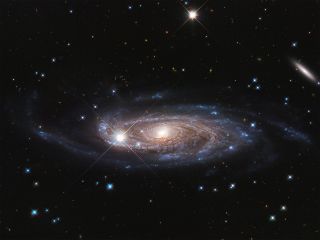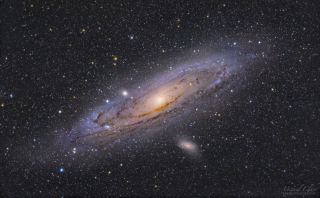
Two cosmic love birds lit the way to the discovery of dark matter, and a new Hubble image features a behemoth galaxy that played a part in the groundbreaking finding.
In 1968, astronomer Vera Rubin used an observatory in southern Arizona to view the Andromeda galaxy. It’s a neighbor of the Milky Way and shares its moniker with the constellation around it. This collection of bright celestial points is named for the Ethiopian princess of Greek mythology, who loved the hero Perseus. Andromeda’s beau also lends his name to a constellation, and rightfully so: The two constellations shine next to each other.
The Andromeda galaxy and another behemoth galaxy located 232 million light-years away in the constellation Perseus helped Rubin cement the idea that invisible dark matter existed and was slowing down their rotation rates.
Related: Messier’s List: Hubble Telescope’s Stunning Views of Deep-Sky Objects

The galaxy within the Perseus constellation is featured in a new image from NASA’s Hubble Space Telescope. The galaxy is known officially as UGC 2885 but is nicknamed Rubin’s galaxy for the trailblazing astronomer, NASA officials said in an image description.
The affectionate name for this massive spiral galaxy comes from Benne Holwerda, a researcher at the University of Louisville in Kentucky, who observed it with the Hubble Space Telescope. Holwerda recently investigated the source of the galaxy’s enormous size and wanted to honor the person who studied Rubin’s galaxy prior to his research.
“My research was in large part inspired by Vera Rubin’s work in 1980 on the size of this galaxy,” Holwerda said in the photo description. “We consider this a commemorative image. This goal to cite Dr. Rubin in our observation was very much part of our original Hubble proposal.”
Dark matter is the invisible material that gave itself away when Rubin figured out something was exerting a gravitational influence on the galaxies’ rotation rates.
Hubble researchers called Rubin’s galaxy a “gentle giant,” according to the image description. It’s 2.5 times wider than the Milky Way and has about 10 times as many stars as our home galaxy. It has about 1 trillion stars, Hubble officials wrote. It might be the largest known galaxy in the local universe.
But the galaxy is a quiet place, slowly siphoning in the hydrogen floating between galaxies to make new stars. Rubin’s galaxy doesn’t appear to have gobbled up any neighboring galaxies in order to grow into its massive size. The calm halo around the galaxy and the “sleeping giant” supermassive black hole at the galactic center support the calm-natured claims, Hubble officials wrote.
But its easygoing lifestyle also means Rubin’s galaxy develops new stars at half the rate of the Milky Way, they added.
Holwerda presented his new research about the galaxy’s massive size at the American Astronomical Society meeting in Honolulu on Jan. 7.
“How it got so big is something we don’t quite know yet,” Holwerda said in the Hubble statement. “It’s as big as you can make a disk galaxy without hitting anything else in space.”
Follow Doris Elin Urrutia on Twitter @salazar_elin. Follow us on Twitter @Spacedotcom and on Facebook.







